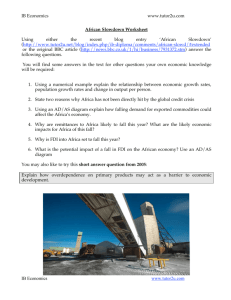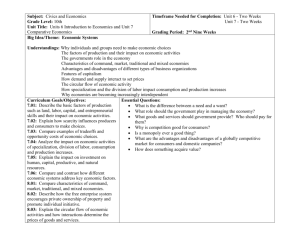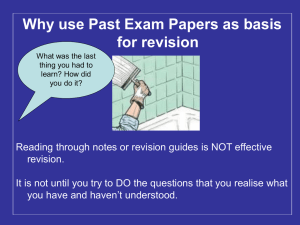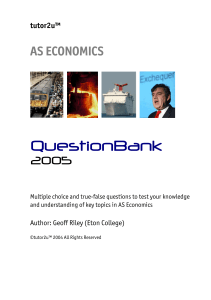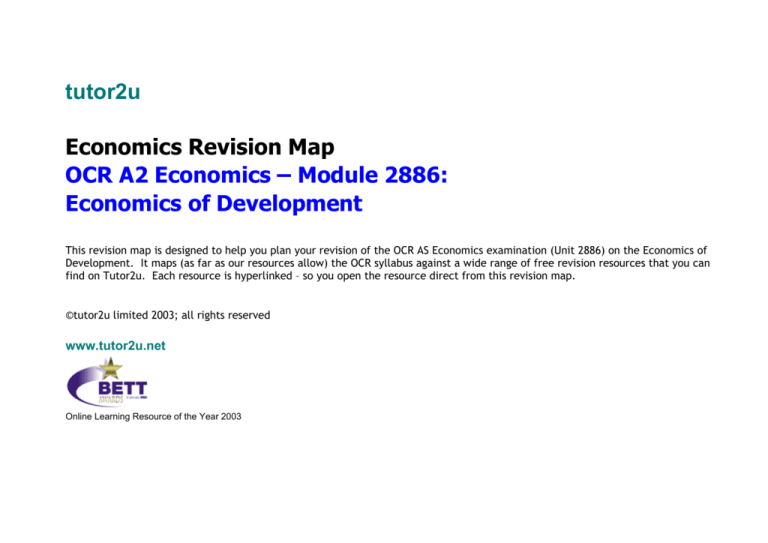
tutor2u
Economics Revision Map
OCR A2 Economics – Module 2886:
Economics of Development
This revision map is designed to help you plan your revision of the OCR AS Economics examination (Unit 2886) on the Economics of
Development. It maps (as far as our resources allow) the OCR syllabus against a wide range of free revision resources that you can
find on Tutor2u. Each resource is hyperlinked – so you open the resource direct from this revision map.
©tutor2u limited 2003; all rights reserved
www.tutor2u.net
Online Learning Resource of the Year 2003
HOW TO USE THIS REVISION MAP
This revision map provides links to a selection of free resources on tutor2u for students taking the OCR AS Unit 2886 examination.
The map is not intended to provide a complete list of all the revision you should do before the exam. But hopefully it will provide some
useful materials that will help supplement your teacher’s resources and other materials you are using for revision.
We recommend highlighting or marking each resource once you have visited the site.
We also recommend trying the interactive quizzes fairly often during your revision – so that you can track your progress. There are
over 1,000 AS standard questions for Economics students alone on tutor2u – plenty to keep you tested!
Please note, you will need a recent version of your favourite internet browser (we recommend Internet Explorer) to get full benefit from
the interactive quizzes.
Please send feedback about this revision map to Jim Riley at jimriley@tutor2u.net so that we can develop the resource for future
students.
Best wishes and GOOD LUCK from everyone at Tutor2u
TABLE OF CONTENTS
1
2
3
4
5
The Concept of Development........................................................................................................................................................................................................4
Economies at Different Stages of Development ...........................................................................................................................................................................5
Theories and Models Linked to Development...............................................................................................................................................................................6
Problems of Developing Economies .............................................................................................................................................................................................7
Policies to promote development ..................................................................................................................................................................................................8
Tick When
Covered
1
Revision Notes
Presentations
Interactive Quizzes
THE CONCEPT OF DEVELOPMENT
Candidates should be able to:
• Define development in terms of material and non-material progress
• Distinguish between development and growth
• Understand the limitations of national income statistics in measuring development
• Understand the HDI and how it improves on national income statistics
Content of the Syllabus:
- The meaning and definition of development. Growth and development
- Measurement: the limitations of national income statistics and the use of the Human Development Index
- The range of terms used to identify economies at different stages of development: developing and developed. Sub-division of developing economies to include
low and middle income countries
- Transition economies, and newly industrialised countries
- Differentiated development within developed economies
Introduction to Development Economics
Economics of Development
Measuring Development
Less Developed Countries
Tick When
Covered
2
Revision Notes
Presentations
Interactive Quizzes
ECONOMIES AT DIFFERENT STAGES OF DEVELOPMENT
Candidates should be able to:
• Understand how the sectors in an economy can be identified and classified;
• Apply these classifications to different types of developing country and to different regions within more developed countries;
• Understand the economic, cultural, political and social influences that have determined an economy’s level of development;
• Analyse how these influences have had impacts on different economies and regions.
Content of the Syllabus:
- The characteristics of different types of developing economy. Similarities and differences between them
- The sectors of an economy: primary, secondary, tertiary and quaternary, formal and informal, rural and urban, traditional and modern
- The economic, political and social influences on development and their occurrence in different types of developing economy: culture, system of government,
colonial background, economic system
Types of Economic Sector
Categorising Countries
Objectives of Economic Development
Market Approaches to Development
State Approaches to Development
Finance, Debt and Terms of Trade
Social Capital and Cohesion
Tick When
Covered
3
Revision Notes
Presentations
THEORIES AND MODELS LINKED TO DEVELOPMENT
Candidates should be able to:
• Explain the difference between absolute and comparative advantage
• Evaluate how external trade can promote economic development and growth
• Understand the assumptions and predictions of the theories and models of economic development and growth
• Understand the limitations of the theories and models
• Apply the theories and models to actual cases
• Discuss their usefulness in the understanding of the process and problems of development
Content of the Syllabus:
- The content and limitations of models and theories linked with development
- Absolute and comparative advantage - the basis for trade, gains from trade and the role of trade in development
- Rostow’s model - the stages of growth
- The Harrod-Domar model - the role of saving and investment
- Lewis’ model - the role of structural change
- Dependency theory – relationships and links between developed and developing economies and regions
- Balanced and unbalanced growth theory - the approach to industrialisation
Introduction to Models of Development
Balanced Growth Theory
Comparative Advantage Theory
Dependency Theory
Harrod-Domar Model
Lewis Model
Rostow Model
Unbalanced Growth Model
Interactive Quizzes
Tick When
Covered
4
Revision Notes
Presentations
Interactive Quizzes
PROBLEMS OF DEVELOPING ECONOMIES
Candidates should be able to:
• Understand the problems faced by developing economies
• Analyse the causes of the problems faced by developing economies
• Analyse the implications of these problems for future development
• Distinguish between problems arising from within the economy and those relating to external factors
• Discuss the relative importance of the different problems
• Discuss the links between domestic and international problems
• Evaluate the extent to which developing economies have similar underlying problems
Content of the Syllabus:
- The causes and the implications of the problems faced by developing economies
- Domestic problems: environment and sustainability, factor endowment, population change and migration, poverty and inequality, savings rates and capital
accumulation, structural change, unemployment and underemployment, weaknesses of financial markets, price instability, and government failure
- International problems: patterns of trade, balance of payments, dependency, foreign debt, terms of trade, international capital flows, exchange rate fluctuations
- The impact of globalisation and the activities of multi-national companies
- Similarities and differences between different types of developing economy
Export and Import Penetration
Foreign Aid
Globalisation
Population and Migration
Structural Issues and Unemployment
Sustainability
Tick When
Covered
5
Revision Notes
Presentations
Interactive Quizzes
POLICIES TO PROMOTE DEVELOPMENT
Candidates should be able to:
• Understand the role of domestic and international institutions in tackling problems of development
• Discuss their relative importance and success
• Analyse the effectiveness of market and state approaches to promoting development
• Understand the scope of domestic and international policies to promote development
• Explain how such policies seek to address the problems of developing countries
• Assess the effectiveness and limitations of these policies
Content of the Syllabus:
- The operation and limitations of policies to promote development. The role of governments, non-government organisations, the IMF, World Bank and World
Trade Organisation. Their contribution and effectiveness in the promotion of development
- The alternative approaches to economic development through the free market and state planning
- Domestic policies: resource improvement and management, promotion of sectoral change, industrialisation, population control, structural adjustment
programmes, macro-economic stabilisation
- International policies including those of the European Union: export promotion and import substitution, foreign debt management, foreign aid, foreign direct
investment, trade agreements and trade liberalisation, currency stabilisation
Government Policy and Development
International Monetary Fund
Multinationals
World Bank
World Trade Organisation





